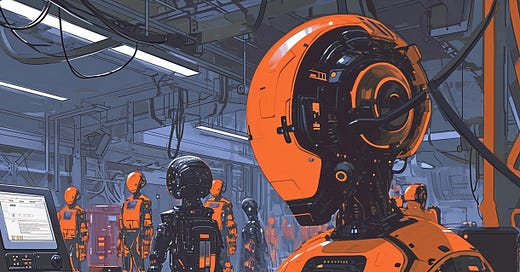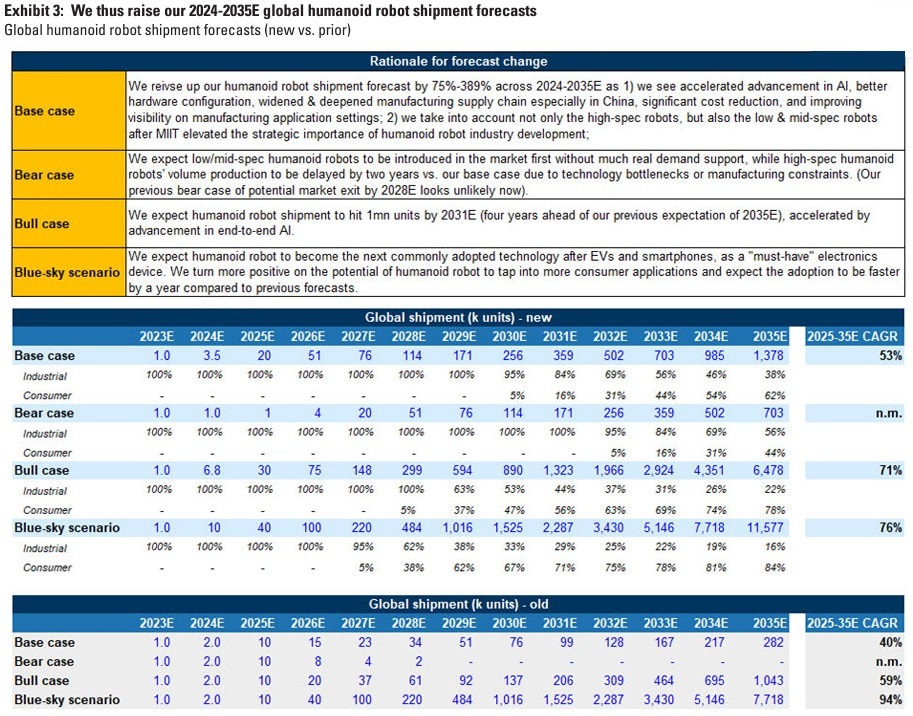🤖 An economic super-boom needs humanoid robots, not just human-level AI
Building machine workers involves difficulties that aren't present with large language models. But progress might be accelerating.
Quote of the Issue
“Ultimately, and probably sooner than most people realize or are willing to acknowledge, a superintelligent AI will arise. If anything, ‘bicycles for the mind’ will help us get there. Because if you could build anything, that would be the thing you would most want to work on.” - Bojan Tunguz
The Conservative Futurist: How To Create the Sci-Fi World We Were Promised
“With groundbreaking ideas and sharp analysis, Pethokoukis provides a detailed roadmap to a fantastic future filled with incredible progress and prosperity that is both optimistic and realistic.”
The Essay
🤖 An economic super-boom needs humanoid robots, not just human-level AI
Consider "transformative AI" as powerful artificial intelligence with the potential to change humanity's trajectory as significantly as did the Agricultural and Industrial Revolutions. As a reminder, here’s how how the Industrial Revolution affected the course of human existence:
I’ll take another one of those exponential events, please! More specifically, one could define warp-speed economic growth in a world of artificial general intelligence or artificial superintelligence as did Open Philanthropy analyst Tom Davidson in a much-discussed 2021 report ”Could Advanced AI Drive Explosive Economic Growth?” His version of transformative/exponential/explosive GDP growth is growth that’s a magnitude higher than what we currently experience in a world without AGI or ASI. Davidson:
It took thousands of years for growth to increase from 0.03 percent to 0.3 percent, but only a few hundred years for it to increase from 0.3 percent to 3 percent. If you naively extrapolate this trend, you predict that growth will increase again from 3 percent to 30 percent within a few decades.
Such rapid growth would be the result of AI automating tasks in the production of goods and in the production of ideas, with the latter especially important for explosive growth. As Stanford University economist Charles I. Jones explains in the paper “The End of Economic Growth? Unintended Consequences of a Declining Population,” economic growth in many economic models “is driven by people discovering new ideas.” But even with a declining population, he continues, “automation and artificial intelligence could enhance our ability to produce ideas sufficientlythat growth in living standards continues even with a declining population, for example. Or new discoveries could eventually reduce the mortality rate to zero, allowing the population to grow despite low fertility.”
Here’s how Jones’ formulas fit sync with Davidson’s views:
Idea-based models explain increasing growth with an ideas feedback loop: more ideas → more output → more people → more ideas… Idea-based models seem to have a good fit to the long-run GWP data, and offer a plausible explanation for increasing growth.
After the demographic transition in ~1880, more output did not lead to more people; instead, people had fewer children as output increased. This broke the ideas feedback loop, and so idea-based theories expect growth to stop increasing shortly after the time. Indeed, this is what happened. Since ~1900 growth has not increased, but has been roughly constant.
Suppose we develop AI systems that can substitute very effectively for human labor in producing output and in R&D. The following ideas feedback loop could occur: more ideas → more output → more AI systems → more ideas… Before 1880, the ideas feedback loop led to super-exponential growth. So our default expectation should be that this new ideas feedback loop will again lead to super-exponential growth.
So, yeah, automating the idea-generation function is important. And if that were happening, you would see a stream of news such as this: “The head of Google DeepMind believes its drug discovery spinout will halve the time taken to find new medicines, attracting the attention of the world’s biggest pharmaceutical companies which are looking to artificial intelligence to revolutionize the lengthy process”
But let’s not forget the part about AI automating the production of goods. For that to happen, it will take great hardware as well as great software. It will take supercapable robots that can easily substitute for most, if not all, human labor. Large language models by themselves aren’t enough. This from AI watcher and Substacker Timothy Lee, author of (which inspired this essay):
Here’s the problem: Current generative AI models are highly effective at tasks involving large datasets gleaned from the internet, like processing text and images, but that’s insufficent to enable real-world robotics. Robots need abundant data from physical interactions to learn how to operate in the physical worlds, data which are costly and time-consuming to produce in labs. Progress has been limited, with robots only able to perform simple behaviors in restricted settings. This is all neatly explained in an IEEE Spectrum essay, “The Global Project to Make a General Robotic Brain,” by Sergey Levine, associate Professor at UC Berkeley and Research Scientist at Google, and Karol Hausman, a staff research scientist at Google DeepMind and an adjunct professor at Stanford. From the piece:
If the abilities of each robot are limited by the time and effort it takes to manually teach it to perform a new task, what if we were to pool together the experiences of many robots, so a new robot could learn from all of them at once? We decided to give it a try. In 2023, our labs at Google and the University of California, Berkeley came together with 32 other robotics laboratories in North America, Europe, and Asia to undertake the RT-X project, with the goal of assembling data, resources, and code to make general-purpose robots a reality. The RT-X project aims to accelerate development by connecting 32 robotics labs to collaboratively pool data and resources at scale, with the goal of creating versatile, general-purpose robots that can operate effectively beyond limited lab settings. … To our surprise, we found that the inclusion of the multirobot data improved the Google robot’s ability to generalize to such tasks by a factor of three. This result suggests that not only was the multirobot RT-X data useful for acquiring a variety of physical skills, it could also help to better connect such skills to the semantic and symbolic knowledge in vision-language models. These connections give the robot a degree of common sense, which could one day enable robots to understand the meaning of complex and nuanced user commands like “Bring me my breakfast” while carrying out the actions to make it happen.
Of course, advances in generative AI certainly are helpful in the pursuit of high-functioning humanoid robots. In a new report, “Humanoid Robot: The AI accelerant,” Goldman Sachs analysts present an optimistic outlook for the humanoid robot market. Some key points:
GS is projecting a substantial increase in the “total addressable market to $38 billion by 2035” up from $6 billion previously, with expected shipments reaching 1.4 million units. This growth is driven by a combination of factors, including “end-to-end AI and multi-modal AI algorithms enabling much faster product iterations, leading players' sooner-than-expected progress (e.g., Tesla Optimus Gen 2), and better capabilities of the robots though possibility for a general purpose AI robot is still a question.”
The cost to build high-end robots has also dropped significantly, by about 40 percent, to $150,000 per unit “driving better application economics, which means factory application viability timeline could be one year earlier (2024E-27E vs. 2025E-28E previously) and consumer applications 2–4 years earlier (2028E-2031E vs. 2030E-2035E).”
GS sees these robots are especially in demand for jobs in places like factories, where they can handle tough tasks on different types of terrain, and in risky jobs that are dangerous, such as mining and disaster rescue. “Our sensitivity analysis suggests humanoid robot demand could reach 1.1mn-3.5mn units globally assuming 5-15% substitution rate for special operations and auto manufacturing to support our base case assumptions. … For our blue-sky scenario, we still expect humanoid robot to become the next commonly adopted technology after EVs and smartphones, and we turn more positive on the potential of humanoid robot to tap into more consumer applications and expect the adoption to be faster by a year compared to our previous forecasts.”
Oh, about that “blue sky” scenario: In a 2022 report, GS described it as one where the humanoid robot sector would be a $150 billion market by 2035 — if the“hurdles of product design, use case, technology, affordability, and wide public acceptance [could] be completely overcome.” Now, as back then, Tesla’s efforts at developing a humanoid robot are seen a reason for optimism:
Tesla released a video in Sept. 2023 to elaborate their end-to-end AI process in Optimus. End-to-end AI is completely different from prior rule-based control, meaning the software system itself can execute the task from original commands and scenarios to final outputs under AI self-generated rules instead of software engineers’ pre-programmed rules. In the video, Tesla Optimus completed the higher-level end-to-end control from scenario observation to task analysis. These two processes are completed by robot LLMs as they have image/text/video reasoning and analysis abilities. The lower-level end-to-end control includes simulation and final execution, where robot AI needs to arrange the workflow of movements (simulation) and then turn into the robot physical movements that we see. On Dec. 13, 2023, Tesla unveiled Tesla Optimus Bot Gen 2 in video format. We note Tesla launched its Gen 1 product nine months back in March 2023 and three months after they demonstrated the end-to-end AI learning capabilities, showing a much faster product iteration and R&D pace than comparable peers.
More encouraing news comes from prediction markets:
This might be another case where my big concern is more about Down Wing (risk averse, degrowth, precautionary principle) public policy and Down Wing public backlash than the state and pace of tech progress.











Interesting!!
BTW, where can I find the GS's report? (“Humanoid Robot: The AI accelerant,”)